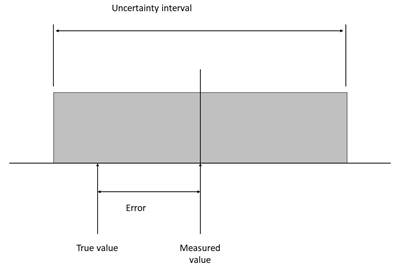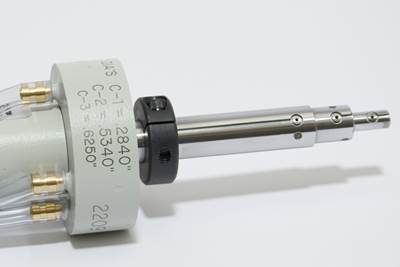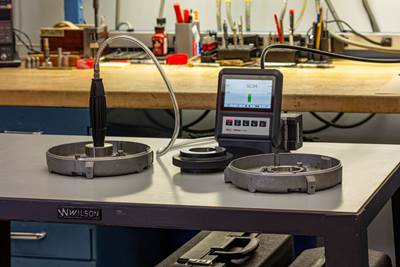-
SPONSORED
-
SPONSORED
-
-
Measurement Tools for Machining
Measurement tools are used to verify that a part’s dimensions conform to required tolerances. They include calipers, micrometers, gages, łŖŇ‚¬ ŃýļŌ≤ s and profilometers.







ESSENTIAL READING
VIEW ALLHow to Evaluate Measurement Uncertainty
Manufacturing and measurement are closely coupled. An important consideration for the use of measurement results is the associated measurement uncertainty. This article describes common metrology terms and provides an example uncertainty analysis.
Read More6 Machine Shop Essentials to Stay Competitive
If you want to streamline production and be competitive in the industry, you will need far more than a standard three-axis CNC mill or two-axis CNC lathe and a few measuring tools.
Read MoreHow to Choose the Correct Fixed-Body Plug Gaging Solution
The two types of fixed-body plug gages are both accurate, fast and easy to use. Consider these factors when selecting one for your gaging application.
Read MoreRethink Quality Control to Increase Productivity, Decrease Scrap
Verifying parts is essential to documenting quality, and there are a few best practices that can make the quality control process more efficient.
Read MoreHow to Calibrate Gages and Certify Calibration Programs
Tips for establishing and maintaining a regular gage calibration program.
Read MoreHow to Choose the Correct Measuring Tool for Any Application
There are many options to choose from when deciding on a dimensional measurement tool. Consider these application-based factors when selecting a measurement solution.
Read MoreLatest Measurement News And Updates
Zeiss Blue Light Scanner Accelerates Part Digitization
PMTS 2025: The ATOS Q blue-light 3D scanner combines high-tech electronics and optics with robust design and software to provide high-precision measurement results across diverse applications.
Read MorePrime Technical Services Monitoring Solutions Support Lights-Out Manufacturing
PMTS 2025: Prime Technical Services Inc. showcases CNC tool monitoring and process control from Caron Engineering, as well as smart manufacturing solutions from Blum-Novotest Inc.
Read MoreMarathon Precision’s Engineering Playground: One Shop’s Secret to Sustaining High Tech, Low-Volume and High Morale
Half an airplane on the wall, a ten-foot metal dragon, and a full-blown recording studio might not scream “manufacturing efficiency,” yet Marathon Precision proves otherwise. Here’s how forging, complex CNC operations and staff-driven creative projects combine to fuel the shop’s productivity and profitability.
WatchZeiss Showcases Innovative Metrology Technology at Online Event
Zeiss will reveal seven new metrology technologies and software updates at its Zeiss Live Tech Reveal on Thursday, February 27, 2025, at 2:00 p.m. ET.
Read MoreRenishaw Measurement System Provides Flexible, High-Volume Gaging
PMTS 2025: Equator measurement systems are designed to provide a fast, highly repeatable and versatile gage for shopfloor use.
Read MoreSimplicity Meets Function in Starrett Programmable Indicator
Programmable, touchscreen-controlled indicators like Starrett’s W4900 can perform a wider range of tasks than either dial or traditional digital counterparts while proving simpler to use.
Read MoreFeatured Posts
Automating Fixed-Body Plug Gaging
How tight-tolerance gaging and in-process automation can converge to streamline manufacturing processes.
Read MoreAutomating Double-Flank Gear Testing
The form and surface finish of individual gears are becoming more demanding. Automated double-flank rolling tests are a particularly realistic measurement that simulates the behavior of the gears in operation.
Read MoreMeasuring Torque, Thrust Force for Smart Drilling Operations
To monitor drilling operations for smart manufacturing solutions, torque and thrust force can be measured.
Read MoreA 100-Year-Old Measurement Tool That is Still Used Today
The reed mechanism was a breakthrough in high-precision measurement and is still used today for sub-micron or even nanometer resolution applications.
Read MoreBuilding Temperature Compensation Into the Gaging Station
As production tolerances become ever tighter and the error margin for measurement results shrinks, manufacturers must consider thermal fluctuations in their inspection processes.
Read MoreVisible Touch: Tactile Sensor Enables Multi-Purpose Inspection
Not only can Gelsight’s tactile sensor detect and evaluate defects, but it can also measure part features, surface roughness and even contamination.
Read MoreFAQ: Measurement
What is a caliper?
Calipers, which can be Vernier, dial or digital, are versatile tools for basic length measurement. They can be used on the shop floor, in the inspection room or even in the home by hobbyists.
Source: Caliper Tips And Tricks
What is a micrometer?
A micrometer consists of two opposing surfaces, a stationary anvil and a moveable spindle. On most micrometers, these hardened steel or carbide-tipped contact surfaces are flat. However, micrometers can also be equipped with contact tips with unique forms for measuring special part characteristics.
Convenience is one of the reasons the micrometer is often the tool of choice for length/diameter measurements. The basic micrometer provides direct size information quickly, has high resolution and is easily adaptable to many different measurement applications.
What is a gauge?
Gages are indirect reading instruments. The measurement units live not on the scale but off-site (for example, in a calibration room), and a master or other standard object acts as their substitute. The workpiece is compared against the master and only indirectly against the measurement units. The gage thus evaluates not the dimension itself, but the difference between the mastered dimension and the workpiece dimension. Examples of these comparative gages include an adjustable bore gage, mechanical snap gages or bench stands with dial indicators.
Gages tend to be faster and more accurate than measuring instruments. This is because they are dedicated to a particular size, and over their short range, they produce higher resolution and hence, greater accuracy.
What does łŖŇ‚¬ ŃýļŌ≤ mean?
A coordinate measuring machine (łŖŇ‚¬ ŃýļŌ≤ ) is a measurement toolÔĽŅ that consists of a motion system, a probing system, a computer and measurement software.
Source: Machining 101: What Are Coordinate Measuring Machines?
Measurement Supplier Categories
- Flatness Measuring Equipment
- Gages, Mechanical
- Laser Measurement Systems
- Calibration Equipment
- Comparators, Optical & Other
- Surface Finish Measuring Equipment
- Gages, Electronic/Digital
- Coordinate Measuring Machines, Portable
- Coordinate Measuring Machines (łŖŇ‚¬ ŃýļŌ≤ s)
- Data Collection Devices for Gaging, SPC, etc.
- Roundness Measuring Equipment






























